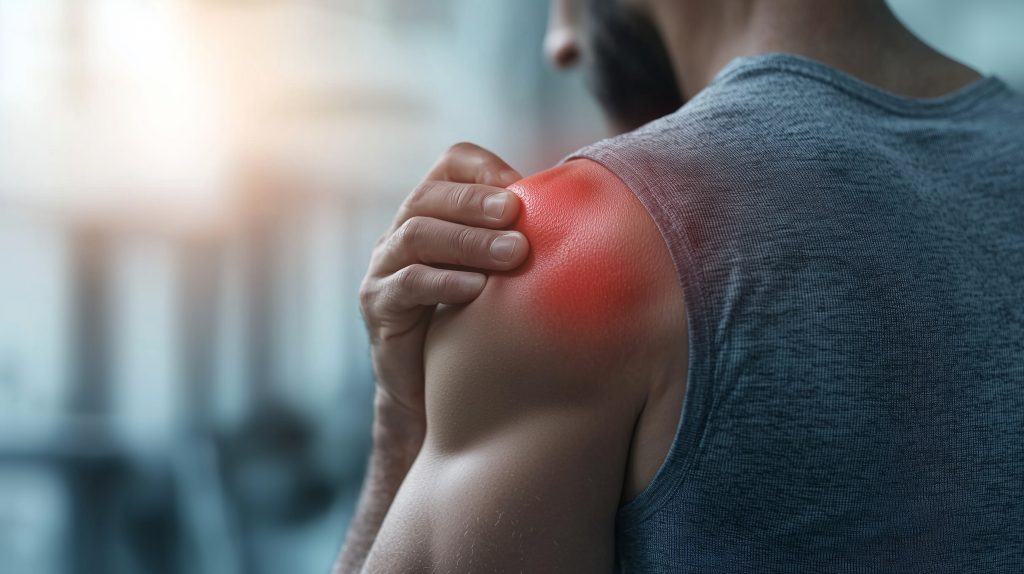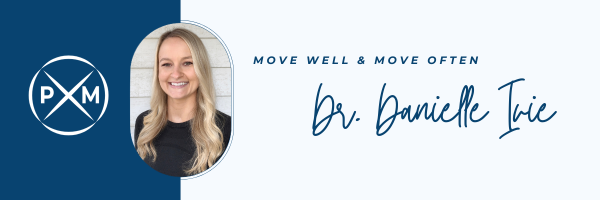Is Your Shoulder Pain Actually Coming from Your Shoulder?
Your Thoracic Spine May Be the Culprit!
Danielle Ivie, DPT, CSCS | Founder of Powered by Movement Physical Therapy

Shoulder pain is one of the most common pain struggles I help my clients overcome. And the tricky thing about shoulder pain is that, more often than not, the shoulder itself is not actually the joint to blame. If you have recurring shoulder pain that is interfering with exercise, pain that resolves with rest but returns when you start lifting overhead, and have been told that you should just stop reaching or pressing overhead – I can help.
Even if your shoulder pain is nagging and you have consulted Dr. Google multiple (maybe a few too many) times without luck, there is hope! I can get you out of this vicious pain cycle by teaching you that the source of pain is not always the cause of your pain, and this is a very common thing I see with shoulder pain.
A huge misconception is that overhead mobility comes from flexible shoulders and the thoracic spine (upper back) is often overlooked. The thoracic spine makes up the upper middle portion of your back and is responsible for most of your spinal rotation. Your thoracic spine moves into flexion (bending forward), extension (arching back or overhead lifting), and rotation (twisting). Adequate mobility in your thoracic spine is essential to optimal function of your neck and shoulders. We say mobility because the goal is to be able to control movement through a full range of motion, not simply have a range of motion that we do not know how to use under load.
Now let’s get real – a huge portion of our daily activities in modern life are in front of us. Think sitting at a computer, having dinner with our family, driving, or scrolling on your phone. Because the bulk of our day is spent in front of us, our thoracic spines get very used to flexion and can become stiff into extension and rotation.
Then, we show up to class and crush a billion overhead presses (which require a significant amount of thoracic extension mobility) and wonder why our shoulders hurt. But what it comes down to is, your shoulders may hurt because they are doing the job of your shoulders and your upper back – and they need some help! *Enter the thoracic spine.*
If you do not have adequate thoracic mobility into extension & rotation, then as you lift overhead or hang from a bar, your thoracic spine cannot extend to get into a position that supports your shoulders. This causes your shoulders to move TOO much to compensate for not enough movement in your upper back. Over time, your shoulders will say “Hey, I’m sick of doing all the work” and send you pain signals to communicate that to you.
If you address shoulder pain thinking your shoulder is the problem, but actually have an upper back problem, you won’t see results. This is how too many of my clients get stuck in the vicious pain cycle I mentioned earlier. Further, even if you don’t have pain from these movement deficits, it could be causing a plateau in your training. Your upper back has the potential to produce significantly more power than your arms. A stronger and more mobile upper back can lead to massive PRs (that’s the fun part).
So how can you determine if you need more thoracic mobility? Try this simple test:
1. Sit on a chair or box with feet supported evenly
2. Hold a PVC on the top of your shoulders with arms crossed
3. Without moving your hips, rotate your trunk to the right.
4. Come back to center, then rotate to the left.
You should be able to achieve at least 45 degrees of rotation to each side.
Are you able to achieve that without moving your hips? Does the rotation feel similar side to side? Or is one side much stiffer than the other? Any pain with these movements?
If you are unable to achieve 45 degrees of rotation to each side, have any pain with this movement, or have a huge difference side to side, thoracic mobility is something you would benefit from working on. This simple change can decrease pain, improve performance, and even make sitting at a desk job all day more comfortable.
Here are two simple thoracic mobility exercises to get you started:
1. Sidelying Thoracic Rotation – 15 reps per side
Keep knees and hips pointed forward as you rotate your chest. Emphasis on getting chest towards the ceiling.
2. Foam Roll Thoracic Extension – 8-12 reps
Feet are on the wall to decrease motion at lower back. Foam roller is at midback/bra line. You should not move or feel any stress across your lower back in this exercise.
Thoracic mobility is a piece to the puzzle of healthy shoulders and overhead movement that is often overlooked. If you are struggling with back or shoulder pain, or have noticed a huge plateau in your training, reach out to me with any questions and I am happy to help!
At PXM, we help active people in the St. Louis area recover from injury, optimize movement, and stay out of pain for the long term while reaching their health & fitness goals. With our unique approach to physical therapy, our top priority is to provide you with holistic, fitness forward healthcare that emphasizes your goals.
We get you back to thriving in the activities you love with our 3 step process:
POWER UP: Diagnose and understand the root cause of your problem.
POWER BOOST: Create a custom plan for you to restore function & get back to what you love.
POWER PEAK: Optimize performance to keep pain away for good & get stronger than ever.
Not sure if PXM is right for you? Have more questions? Schedule a Free Consultation today.

